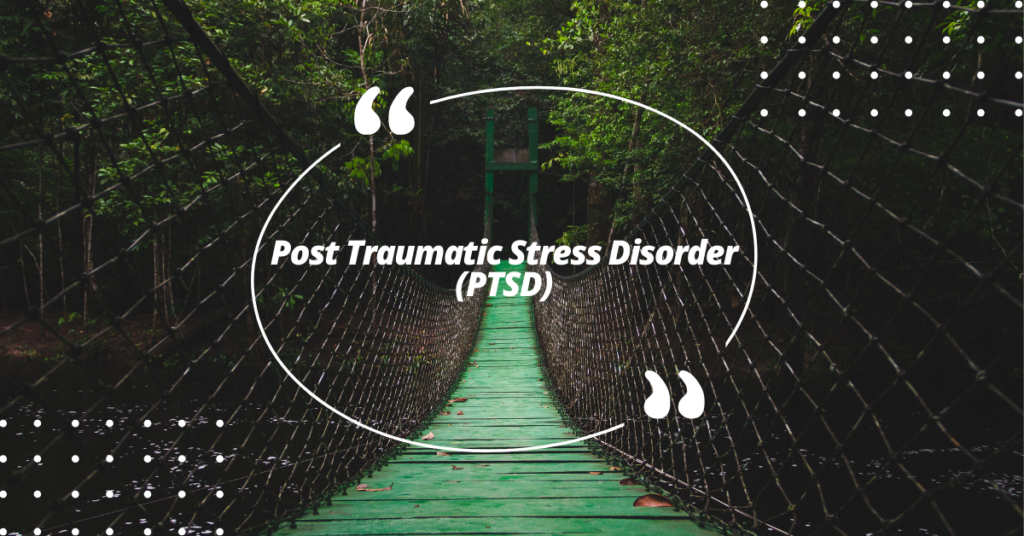
Post Traumatic Stress Disorder (PTSD) casts a profound shadow on the lives of those who have experienced trauma, unveiling a complex emotional terrain that demands understanding, empathy, and support. In this exploration, we delve into the vital role of family support in nurturing healing and resilience for individuals grappling with PTSD.
Unravelling common misconceptions about PTSD seeks to foster a more compassionate understanding of this condition, challenging stereotypes that can hinder the journey to recovery. Additionally, we address the question of whether PTSD, with its intricate tapestry of symptoms, can be outgrown, recognizing the nuanced nature of healing after trauma. Join us on a journey that blends empathy, education, and support to navigate the complexities of PTSD and illuminate pathways toward healing and resilience.
A Brief History of Post Traumatic Stress Disorder (PTSD)
The recognition and understanding of Post-Traumatic Stress Disorder (PTSD) have evolved over time, reflecting an increased awareness of the profound impact that traumatic experiences can have on mental health. The roots of PTSD as a diagnostic entity can be traced to historical instances where the psychological toll of war and trauma became evident.
The history of PTSD reflects a journey from initial observations to a comprehensive understanding of the psychological impact of trauma. As awareness grows, so does the commitment to supporting those affected by PTSD, emphasizing the importance of compassionate care and effective interventions.
The diagnosis of Post-Traumatic Stress Disorder (PTSD) involves a meticulous evaluation based on specific criteria outlined in the Diagnostic and Statistical Manual of Mental Disorders (DSM-5). Here is an overview of the diagnostic criteria:
DSM-5 Diagnostic Criteria for PTSD:
To be diagnosed with PTSD, an individual must meet the following criteria:
- Exposure to Traumatic Event(s):
- The individual has been exposed to actual or threatened death, serious injury, or sexual violence through direct experience, witnessing, or learning about the event.
- Intrusion Symptoms:
- The presence of one or more intrusion symptoms associated with the traumatic event(s), including distressing memories, nightmares, flashbacks, and intense psychological distress or physiological reactivity when reminded of the event.
- Avoidance:
- Persistent avoidance of distressing memories, thoughts, feelings, or external reminders associated with the traumatic event(s).
- Negative Alterations in Cognitions and Mood:
- Negative alterations in mood and cognition related to the traumatic event(s), such as distorted beliefs about oneself or the world, persistent negative emotions, diminished interest in activities, feelings of detachment, and an inability to experience positive emotions.
- Alterations in Arousal and Reactivity:
- Marked alterations in arousal and reactivity, including hypervigilance, exaggerated startle response, difficulty concentrating, irritability, angry outbursts, and sleep disturbances.
- Duration of Symptoms:
- The duration of symptoms must persist for at least one month.
- Functional Impairment:
- Symptoms must cause clinically significant distress or impairment in social, occupational, or other important areas of functioning.
- Differential Diagnosis:
- The symptoms are not attributable to the physiological effects of a substance (e.g., medication, substance use) or another medical condition.
ICD-10 Code for Post Traumatic Stress Disorder (PTSD):
In the International Classification of Diseases, 10th Edition (ICD-10), PTSD is coded as F43.1. This alphanumeric code specifically identifies and classifies PTSD within the broader category of reactions to severe stress and adjustment disorders.
Diagnosing Post traumatic stress disorder
Diagnosing PTSD involves a careful consideration of an individual’s experiences, symptoms, and their impact on daily functioning. The DSM-5 criteria provide a standardized framework for mental health professionals to assess and diagnose PTSD, while the ICD-10 code ensures a standardized method of classification for international healthcare systems. Understanding and applying these criteria contribute to a more accurate diagnosis and the development of targeted treatment plans for individuals grappling with the aftermath of trauma.
The diagnosis of Post-Traumatic Stress Disorder (PTSD) involves a meticulous and multifaceted assessment process aimed at capturing the nuanced manifestations of trauma-related symptoms. Mental health professionals employ various tools and techniques to ensure an accurate and thorough evaluation. Here’s an insight into the comprehensive approach to diagnosing PTSD:
- Clinical Interview:
The cornerstone of the diagnostic process is the clinical interview, conducted by a qualified mental health professional. This interview allows for a detailed exploration of the individual’s history, experiences, and the impact of traumatic events on their mental health.
- Diagnostic Criteria:
PTSD diagnosis follows specific criteria outlined in the Diagnostic and Statistical Manual of Mental Disorders (DSM-5), published by the American Psychiatric Association. The DSM-5 criteria include exposure to a traumatic event and the presence of specific clusters of symptoms: intrusion, avoidance, negative alterations in cognitions and mood, and alterations in arousal and reactivity.
- Trauma Exposure Assessment:
Evaluating the nature and extent of trauma exposure is crucial. Understanding the specific events and their impact helps contextualize the symptoms and contributes to a more accurate diagnosis.
- Symptom Clusters:
PTSD symptoms are categorized into clusters:
Intrusion: Re-experiencing the traumatic event through flashbacks, nightmares, or distressing memories.
Avoidance: Efforts to avoid reminders of the trauma, including places, people, or activities.
Negative Alterations in Cognitions and Mood: Persistent negative beliefs, distorted thoughts about oneself or others, and pervasive negative emotions.
Alterations in Arousal and Reactivity: Hypervigilance, exaggerated startle response, difficulty concentrating, and sleep disturbances.
- Duration and Severity:
The persistence and severity of symptoms are assessed. For a diagnosis of PTSD, symptoms must last for at least one month and significantly impact the individual’s daily functioning.
- Differential Diagnosis:
Distinguishing PTSD from other mental health conditions with similar symptoms is crucial. Conditions such as acute stress disorder, adjustment disorders, and other anxiety or mood disorders may share overlapping features.
- Self-Report Measures:
Individuals may be asked to complete self-report measures or questionnaires designed to assess the severity and impact of their symptoms. These measures provide additional quantitative data to support the diagnostic process.
- Behavioral Observation:
Direct observation of the individual’s behavior, including responses to trauma-related cues, adds valuable information to the diagnostic evaluation.
- Medical and Psychosocial History:
Gathering information about the individual’s medical and psychosocial history, including any pre-existing mental health conditions, contributes to a more comprehensive understanding of the individual’s context.
- Collaboration and Multidisciplinary Input:
Collaboration with other healthcare professionals, such as psychiatrists or neurologists, may be sought to rule out medical conditions or address coexisting mental health concerns.
Treatment approaches
The treatment landscape for Post-Traumatic Stress Disorder (PTSD) encompasses a range of therapeutic modalities aimed at alleviating symptoms, fostering resilience, and supporting individuals on their journey toward recovery. Here, we explore comprehensive treatment approaches that address the diverse and intricate aspects of PTSD:
1. Psychotherapy (Talk Therapy):
- Cognitive-Behavioral Therapy (CBT): CBT is a widely recognized and evidence-based approach for PTSD. It focuses on identifying and challenging distorted thought patterns, modifying behaviors, and developing effective coping strategies. Exposure therapy, a component of CBT, helps individuals confront and process traumatic memories.
- Eye Movement Desensitization and Reprocessing (EMDR): EMDR involves guided eye movements while recalling distressing memories. This therapeutic approach aims to help individuals process traumatic experiences, reducing the emotional charge associated with those memories.
- Trauma-Focused Cognitive Therapy (TF-CBT): Specifically designed for individuals, especially children, who have experienced trauma, TF-CBT combines cognitive-behavioral techniques with trauma-sensitive interventions.
2. Medication:
- Selective Serotonin Reuptake Inhibitors (SSRIs): Antidepressant medications, particularly SSRIs like sertraline and paroxetine, are commonly prescribed to manage symptoms of PTSD. These medications can help alleviate depression, anxiety, and intrusive thoughts.
- Medications are prescribed to address nightmares and sleep disturbances associated with PTSD.
3. Neurocognitive Techniques:
- Biofeedback and Neurofeedback: These techniques involve monitoring and training physiological responses, such as heart rate and brainwave patterns, to enhance self-regulation and reduce symptoms of hyperarousal.
4. Group Therapy:
- Peer Support Groups: Connecting with others who have experienced similar traumas provides a supportive environment for sharing experiences, coping strategies, and fostering a sense of belonging.
- Skills Training Groups: Group therapy settings can offer opportunities to learn and practice coping skills, interpersonal effectiveness, and emotional regulation.
5. Family Therapy:
- Involving family members in therapy can enhance understanding, communication, and support. Family therapy addresses the impact of trauma on the entire family system.
6. Mind-Body Interventions:
- Yoga and Mindfulness: Practices like yoga and mindfulness can help individuals reconnect with their bodies, manage stress, and improve overall well-being.
7. Pharmacotherapy:
- Medications may be prescribed to manage specific symptoms, such as sleep disturbances, anxiety, or mood swings. However, medication is often considered adjunctive to psychotherapy.
8. Strength-Based Approaches:
- Focusing on an individual’s strengths and resilience is integral to the healing process. Strength-based approaches emphasize building on existing capabilities and fostering a positive outlook.
9. Holistic Therapies:
- Art and Music Therapy: Creative expressions through art and music can serve as powerful tools for individuals to process emotions and communicate experiences that may be challenging to verbalize.
10. Holistic Lifestyle Practices:
- Embracing a holistic approach involves promoting overall well-being through healthy lifestyle choices, including regular exercise, balanced nutrition, and sufficient sleep.
Family Support in Post-Traumatic Stress Disorder (PTSD): Nurturing Healing and Resilience
Family support plays a vital role in helping individuals with PTSD navigate their journey toward healing. Here are key ways families can offer support:
- Understanding Triggers:
Families can educate themselves about PTSD triggers and symptoms. Understanding the nature of trauma and its effects helps family members empathize with the challenges faced by their loved one.
- Encouraging Professional Help:
Families can encourage individuals with PTSD to seek professional help, such as therapy or counseling. Supporting and participating in the treatment process can contribute significantly to the individual’s recovery.
- Creating a Safe Environment:
Establishing a safe and supportive environment at home is crucial. Individuals with PTSD may need a space where they feel secure, understood, and not judged for their reactions to trauma.
- Patience and Active Listening:
Patience is essential in supporting someone with PTSD. Families can practice active listening, allowing their loved one to share their experiences and feelings without judgment or pressure.
- Recognizing Signs of Distress:
Families should familiarize themselves with signs of distress and be attuned to changes in behavior or mood. Recognizing these signs early allows for timely intervention and support.
- Participating in Treatment:
Attending therapy sessions, when appropriate, can help family members gain insights into PTSD and learn effective ways to support their loved one. Family therapy may also be beneficial in improving overall family dynamics.
Common Misconceptions about PTSD: Challenging Stereotypes for Understanding
1. Immediate Onset of Symptoms:
- Myth: Symptoms of PTSD always appear immediately after a traumatic event.
- Reality: While some individuals may experience immediate symptoms, others may develop PTSD months or even years after the trauma.
2. Limited to War Veterans:
- Myth: PTSD only affects war veterans.
- Reality: PTSD can result from various traumatic events, including accidents, natural disasters, or interpersonal violence, and can impact anyone.
3. Overexaggerated Responses:
- Myth: Individuals with PTSD overreact or exaggerate their responses to triggers.
- Reality: Responses to triggers are often involuntary and linked to the physiological and psychological impact of trauma.
4. Permanent and Untreatable:
- Myth: PTSD is a permanent and untreatable condition.
- Reality: With appropriate treatment and support, individuals with PTSD can experience significant symptom relief and lead fulfilling lives.
Can PTSD Be Outgrown?
PTSD is generally considered a chronic condition, but the course of the disorder varies among individuals. While the core symptoms may persist, many individuals can experience significant improvements with treatment. Early intervention, therapy, and a supportive environment contribute to enhanced coping mechanisms and a better quality of life. While PTSD may not be fully “outgrown,” individuals can learn to manage and mitigate the impact of trauma, fostering resilience and recovery over time.
As we conclude our exploration of Post-Traumatic Stress Disorder (PTSD), we recognize that the journey to healing is both individual and collective. Beyond the diagnostic criteria and treatment modalities lies a profound narrative of strength, resilience, and the human spirit’s capacity to overcome adversity. The comprehensive treatment approaches discussed offer a roadmap toward recovery, acknowledging the complexities of trauma and the diverse paths individuals may tread. It is a journey marked by courage, guided by the compassionate hands of mental health professionals, and often buoyed by the unwavering support of families and communities. While the scars of trauma may linger, they need not define the entirety of one’s story. With each step forward, individuals with PTSD reclaim agency, rebuild connections, and rediscover a sense of wholeness. Let this be a testament to the transformative power of understanding, empathy, and the unwavering belief that, even in the aftermath of trauma, the human spirit has the capacity to heal, flourish, and embrace hope.
Written By –
Ms. Sabeera Nowreen
Psychologist




